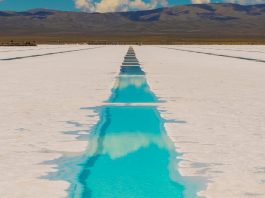Candle Lithium Corporation is using its expertise and experience to advance and support Direct Lithium Extraction (DLE) in North America.
Candle lithium (Candle) was founded in 2019 to commercialise its proprietary chemical process in order to produce lithium products from unconventional brines, such as lithium-bearing oilfields and geothermal brines. We understood the challenges from early on and designed our process in a way to address them while providing an economically viable solution to our partners.
We are well-positioned, working on lithium extraction technologies since late 2016. Back then, Direct Lithium Extraction (DLE) was still in its infancy, and it had not received the attention that we are seeing today.
Since there is no major North American lithium production and most brine deposits are low-grade compared to their South American counterparts, there was an opportunity to tap into these resources using DLE.
After working with a few resource and oil and gas companies, the challenges of working on such deposits – high temperature, presence of hydrocarbon and H2S – became clear to us.
Our core objective is to support the domestic production of lithium in North America to lessen our reliance on imports. We want to achieve this sustainably without disturbing the environment. Our objectives are well aligned with the Canadian Government’s critical minerals strategy and policies, and we have been fortunate to have federal and provincial government support.
What is the outlook for the North American lithium supply? Is it positioned to meet rising demand?
The global lithium (Li) supply is under significant strain due to the increased demand for rechargeable lithium-ion battery production that supplies electric vehicles, consumer electronics, and household appliances.
Global production of Lithium Carbonate Equivalent (LCE) reached 540,000 tonnes in 2021, while the World Economic Forum, along with most industry forecasts, projects demand to grow to 1.5 million tonnes in 2025 and over 3 million tonnes by 2030. It is predicted that 95% of the lithium demand over the next decade will be allocated to battery production.
Apart from Albemarle evaporation ponds in Nevada, lithium is mainly produced in South America and Australia and refined in China. The North American hard rock, clay, and new brine projects are touted to come online in the next three to six years.
Given the complexity of developing such projects and rapid demand growth for electric cars, projects with shorter timelines to production need to be prioritised to meet the rising demand. This is where we see a significant opportunity for technologies like the one that Candle is developing, which requires less upfront cost and lead time.
How is Candle Lithium advancing and revolutionising Direct Lithium Extraction?
Candle Lithium is advancing its technology by leveraging the team’s broad experience in lithium extraction, oil and gas, engineering, and chemistry. We are a team of scientists and engineers focused on developing a lithium extraction process which can unlock lithium-bearing brines with 20 parts per million (ppm) lithium to 500 ppm.
The majority of the resources in North America contain significant salt, low lithium concentration hydrogen sulfide, hydrocarbon, and they are typically pumped to the surface at high temperatures.
There have been patents from the early 1970s that Direct Lithium Extraction can be used on such brines; however, no commercial lithium production has been reported. For more than four years, we studied the parameters that affect our process efficiency and addressed the aforementioned challenges. We have now developed a continuous process that is resilient and can extract more than 95% of lithium. This has been scaled up seamlessly from bench to small pilot.
Candle has spent 6 years developing sorbents and has created a formula which yields a highly resilient material with excellent selectivity towards lithium. Candle’s sorbents can economically extract lithium from a broad spectrum, in terms of composition, of lithium bearing brine sources.
Our next step is to build a 50m3 per day pilot, which will be one of the largest DLE pilots. We anticipate processing hundreds of cubic meters of brine, refine our design, and fine-tune the process for commercial deployment.
How does your approach differ and compare to other lithium mining companies?
Candle Lithium is focused on tapping into brownfield projects to minimise the need for traditional mining operations and reduce the ecological footprint associated with lithium extraction.
We work with oil and gas or other potential mining companies who are already producing brine as part of the oil and gas production. Infrastructure, including pipelines and roads, is already in place to lower our capital cost.
Additionally, since brine is produced as part of oil and gas production, our operating cost will be lower. Our plant will be placed downstream of oil production prior to brine reinjection without any disruption to their production. The brine will be borrowed for lithium extraction, and a more concentrated, refined lithium product will be produced. Lithium-void brine will then be returned to the disposal pipelines following our extraction process.
The compatibility of our technology with hydrocarbon or H2S will also save us significant capital and operating costs.
From technology development perspective, we have scaled up the process incrementally over the past four years, starting from a small bench unit to a small pilot. This has allowed us to be nimble in addressing any potential scaleup concern and achieve our milestones with minimal capital investment.
The process is thoroughly tested on each brine project for several months, and so far, we have tested more than a dozen brines, and have achieved a high lithium extraction rate regardless of lithium concentration and brine origin.

Can you provide more detail on your key projects and your partners?
We are currently working with multiple oil and gas and lithium mining companies. Our oil and gas partners are active in western Canada and their brine assets have less than 50 ppm of lithium, which is far less than the South American salars.
Nevertheless, our process has shown remarkable performance by extracting more than 95% of the lithium and concentrating it at bench and lab pilot scales. We achieved this performance without much pretreatment, which lowers our operating costs and shortens the processing time.
The results have been shared with the partner and the next step for us is to process their brine on a much larger scale with an eye on commercial demonstration plant operation in the next two years.
Candle Lithium also has agreements in place with two lithium project developers in the United States, one of which is Morella Corporation, based out of Perth, Australia. Morella’s Fish Lake Valley project is located in Nevada, and we have been working on it since 2021.
The technology has been tested on their brine collected from different depths multiple times and we have achieved excellent lithium recovery and selectivity. Morella and Candle are exploring the pathway to pilot the technology on Morella’s brine.
In addition to these projects, we continue to hold conversations with brine project developers and oil and gas companies.
What needs to be done to ensure a reliable, sustainable supply of lithium?
For many years, China has had a stronghold on lithium refining and its exports to the rest of the world. The demand growth for its use in electric cars has spurred Canadian and US governments to list lithium as a strategic mineral, and we have witnessed significant support for the domestic production of lithium in North America.
However, hard rock mining projects are typically capital intensive and clay projects are rather new in the lithium industry, and they both require significant upfront capital cost. Unconventional brine resources, on the other hand, are rather abundant in North America and their chemistry and origin are well understood and documented. In many areas, brine is already being produced as part of oil and gas production and it is reinjected as a waste stream.
With the right technology these projects can come online much faster than hard rock or clay projects. The bottleneck for lithium production from these resources has been the lack of an economically viable technology to extract and produce lithium.
We believe more public and private sector support should be allocated to develop Direct Lithium Extraction technologies to accelerate their development and commercialisation.
Moreover, the regulatory framework associated with the development of brine-hosted minerals is still evolving in different jurisdictions, and more attention from regulatory bodies is required to develop clear policies and regulations.
What does the future hold for Candle Lithium and the lithium market in general?
Candle Lithium has an exciting plan for 2024 to build and operate our pilot plant in Alberta, which is a critical step towards the commercialisation of our technology in the following years. In parallel, we are discussing commercial demonstration plant installation on one of our partners’ sites.
Since Candle’s process can be a bolt-on technology to existing oil and gas facilities, our deployment time will be short with lower initial capital investment. We anticipate to be commercially producing lithium from oil and gas produced water by 2026 and expanding our projects rapidly in North America, which is well aligned with the demand growth in the lithium market.
Of course, there will be more players in this space as other technologies will become more refined and mature making the space more competitive, which is good for the lithium industry in general.
Despite the decline in lithium carbonate prices in places like China and recent studies on alternative batteries, we have seen more investment in lithium space, and the appetite for lithium has not faded away. Most experts predict that lithium will remain the dominant battery material for many years to come and continue to play a central role in the EV revolution.
Please note, this article will also appear in the sixteenth edition of our quarterly publication.









